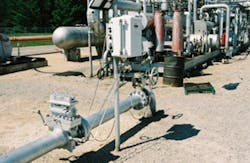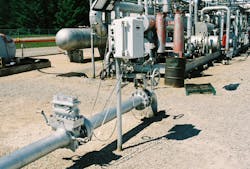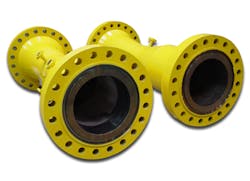Pressure Transmitter Perspectives
Pressure is one of the four main variables that are measured in a process environment; the other three are flow, temperature, and level. While pressure in a process is typically measured with pressure transmitters that include a transmitter and a sensor, some pressure measurement is also done by transducers. Pressure transducers are generally lower in cost and smaller than pressure transmitters, and they are widely used outside the process industries. They typically have loose wires at one end, and do not perform at the same level as pressure transmitters.
Types of Pressure Transmitters
Probably the most important distinction within the pressure transmitter market is among the four types of pressure transmitters:
- Multivariable (MV) pressure transmitters measure two or more process variables—usually pressure and temperature—in a single device.
- Differential pressure (DP) transmitters measure the difference in pressure upstream and downstream of a constriction in a pipe called a primary element.
- Gauge pressure transmitters measure an amount of pressure that includes atmospheric pressure.
- Absolute pressure transmitters measure an amount of pressure that does not include atmospheric pressure.
Like multivariable transmitters, DP transmitters also rely on a constriction in the pipe to create a difference in pressure in the flowstream. Orifice plates are the most common type of primary element. Orifice plates are round, usually metal plates that have a hole or orifice cut into them. There are a number of different types of orifice plates, depending on the position and shape of the hole. Some have multiple holes with different shapes. They have some disadvantages though, such as pressure drop and susceptibility to clogging if there are impurities in the flow stream.
RELATED: Advances in Pressure Measurement Technology Give End-Users More Options to Consider
Other types of primary elements include Venturi tubes, flow nozzles, Pitot tubes, wedge elements, and laminar flow elements. Venturi tubes have a wide opening that curves inward, and are often used with large line sizes. Flow nozzles are shorter in length than Venturi tubes and are often used for steam flow. Pitot tubes measure flow at a single point. However, averaging Pitot tubes have been developed that measure flow at multiple points, thereby providing higher accuracy. Averaging Pitot tubes are widely used to measure the flow of stack and exhaust gases. Here they compete with ultrasonic and thermal flowmeters.
DP transmitters are used to measure both flow and level, though flow is the more common of the two. Hydrostatic tank gauging is a common level application. Applications for DP flow transmitters with primary elements include custody transfer of natural gas, air flow measurement, stack gas measurement, many types of liquid flow measurement, and subsea applications for oil and gas drilling. DP transmitters can be used almost anywhere flow measurement is needed, except for slurries and other applications where the liquid has impurities that could clog a primary element. Venturi tubes and flow nozzles handle impurities better than orifice plates and averaging Pitot tubes.
Both absolute and gauge pressure transmitters can be used in flow measurement, though neither one can measure flow directly. Absolute and gauge transmitters can be used to provide a pressure measurement for a multivariable flowmeter. In this case, the differential-pressure component of the multivariable flowmeter is making the volumetric flow measurement, while the absolute or gauge pressure transmitter is providing a pressure reading that is necessary for computing mass flow.
The difference between absolute and gauge pressure transmitters is that absolute transmitters are sealed off from the atmosphere and so their reading does not include atmospheric pressure. Gauge pressure transmitters, by contrast, are open to the atmosphere and their reading includes atmospheric pressure. While pressure transmitters have replaced many of the early mechanical pressure gauges, dial gauges are still widely used when a pressure reading is required and there is no need to output the reading in signal form to another device.
Pressure Sensing Technologies
The three main pressure sensing technologies used in pressure transmitters are: Piezoresistive, strain gauge/gage and capacitive. Piezoresistive is the leading sensing technology, followed by strain gauge.
Piezoresistive
Piezoresistive pressure sensors typically contain several thin wafers of silicon that are embedded between protective surfaces. The surfaces are connected to a Wheatstone bridge, which is able to detect differences in resistance. A small amount of current passes through the pressure sensor. Less current passes through the sensor as the resistance changes. This difference is detected by the Wheatstone bridge, and a reduced amount of pressure is reported.
Strain gauge
Strain gauge pressure sensors measure the displacement of an elastic diaphragm as a result of a pressure differential across the diaphragm. In a strain gauge sensor, the strain gauge is bonded into a diaphragm and wired into a Wheatstone bridge configuration. The strain generates a change in electrical resistance that is proportional to pressure.
Capacitive
Capacitive pressure sensors have a thin diaphragm as one plate of a capacitor. The diaphragm is exposed to the reference pressure on one side and the process pressure on the other. Changes in pressure cause a change in the capacitance. While stainless steel is the most commonly used diaphragm material, Hastelloy and Inconel also give good results. Tantalum is used for high-temperature applications.
4 Key Trends in Pressure Transmitters
The pressure transmitter market has grown substantially in the past several years. Here are some of the top trends in this market.
Multivariable Transmitters
Multivariable transmitters can be used to reduce the need to buy a separate flow computer to perform the flow calculation. If individual pressure and temperature transmitters are used, the value outputs are sent to a flow computer that performs the flow calculation. For multivariable flowmeters, the computing power of the flow computer is typically brought on board the multivariable transmitter, which also performs the flow calculation. The trend toward multivariable transmitters can be expected to continue in the DP transmitter and flowmeter markets. These products typically sell for less than it would cost to buy the transmitters separately.
Multivariable Transmitters with Integrated Flow Element
Emerson Rosemount (www.rosemount.com) and other companies have introduced a multivariable transmitter that includes an integrated primary element, resulting in a full-fledged multivariable flowmeter. This has the advantage that the flowmeter can be calibrated with the primary element already mounted on it. It also makes it unnecessary for end-users to deal with two different suppliers when buying a DP transmitter and a primary flow element, such as an orifice plate or a flow nozzle.
Wireless Transmitters
Wireless pressure transmitters are becoming more popular, especially for new installations. They can be installed in hard-to-reach locations, typically offer lower installations costs, and make it easier to add measurement points to a process. While wireless still represents a small percentage of the total pressure transmitter market, expect this trend to grow.
Energy Markets Drive Growth
Increased investments in the energy markets are driving pressure transmitter growth. More measurement points have to be monitored as it becomes more difficult to access natural resources in remote locations. At the same time, environmental regulations are making it necessary to increase the number of measurement points. This is true for both absolute and gauge pressure transmitters, as well as for DP flow transmitters.
With improved economic conditions worldwide, and many delayed projects coming back online, growth and innovation in the pressure transmitter market can be expected to continue.
Jesse Yoder, Ph.D., is president and founder of Flow Research Inc. He has 27 years of experience as an analyst and writer in process control and specializes in flowmeters and other field devices, including pressure and temperature products. Contact him at [email protected].
Jesse Yoder
Jesse Yoder, Ph.D., is president of Flow Research Inc. He has 30 years of experience as an analyst and writer in instrumentation. Yoder holds two U.S. patents on a dual-tube meter design and is the author of "The Tao of Measurement," published by ISA. He may be reached at [email protected]. Find more information on the latest study from Flow Research, "The World Market for Gas Flow Measurement, 4th Edition," at www.gasflows.com.






